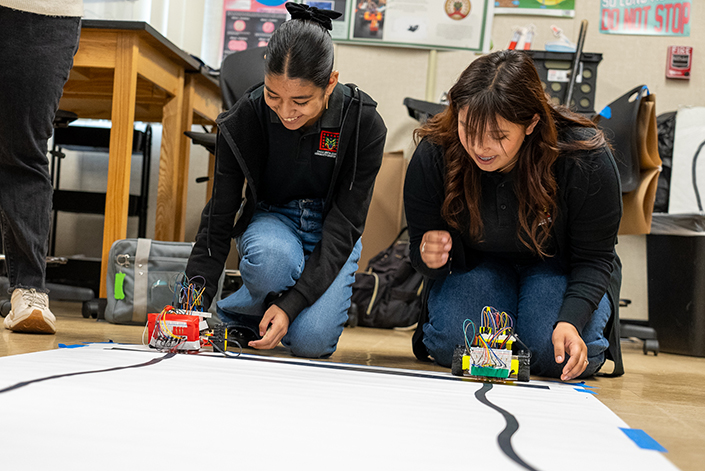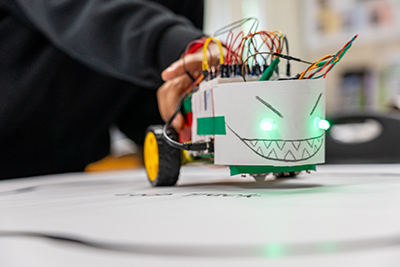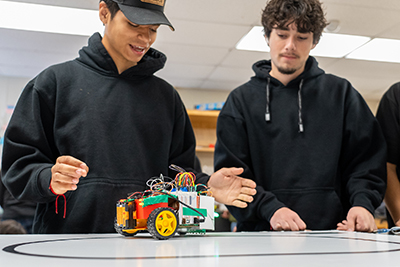Expanding Early Access to Engineering Courses
UC San Diego’s award-winning electrical engineering curriculum is now offered at a Chula Vista high school
Story by:
Published Date
Article Content
Last spring, high school students at Chula Vista Learning Community Charter School built a remote controlled LED light; an audio amplifier; 3D printed a design of their own creation; and developed a line-following robot. They learned all the engineering and computer science skills required to complete these team-based, hands-on projects through an award-winning introductory electrical engineering class developed at the University of California San Diego. The class was offered to high school students for the first time in 2023 in an effort to expand earlier access to engineering concepts and skills.
Electrical engineering faculty at UC San Diego partnered with the UC San Diego Division of Extended Studies to offer the class to these high school students right at their own school, during their school day. Roughly 50 students at CVLCC have taken the class in the two years it has been offered, gaining hands-on experience with engineering skills, and insight into what it looks like to be an engineer. The course — ECE5: Making, Breaking and Hacking Stuff — is offered to first year engineering students at UC San Diego, as well as students in the preparatory Summer Engineering Institute. It’s the first in a series of award-winning electrical engineering courses centered on hands-on, team-based projects offered at the Jacobs School of Engineering.

The goal of ECE5 is to give freshmen students confidence, motivation, and insight into what is to come in the rest of their undergraduate careers through a series of hands-on projects. Electrical engineering faculty at UC San Diego actively worked to share this curriculum and serve as a model that has been adopted by other universities and community colleges around the country, but this offering is the first time the course has been taught in a high school.
Adrian Mercado, a junior at CVLCC who took the ECE5 course in 2023 and returned to serve as a teaching assistant for the class in 2024, said this was his first experience with this type of class, and it was hugely influential.
“I haven’t had much offered like this in my schools— in elementary there was an after school robotics club that I was part of, but that was about it,” said Mercado. “It was pretty challenging, especially because I had never done coding before. But this class got me interested in computer science, which is what I want to study now.”
In fact, Mercado and a friend were so intrigued that they took a computer science summer course offered by UC San Diego Extended Studies to further advance their skills.

"We are thrilled to extend UC San Diego’s cutting-edge electrical engineering curriculum to high school students through this unique partnership with Chula Vista Learning Community Charter School,” said Maysoon Dong, Senior Program Manager for the Education and Community Outreach Department at UC San Diego Extended Studies. “By bringing the ECE5 course directly into high schools, we are not only expanding access to advanced engineering education but also igniting a passion for engineering and technology among young learners. Our goal is to provide these students with an early glimpse into the exciting world of engineering, helping to shape the next generation of innovators and problem-solvers."
Providing this type of encounter with engineering principles and early support to the next generation of engineers is exactly the goal of offering the course to high school students, said Karcher Morris, an electrical engineering teaching professor at UC San Diego, who teaches several courses in this hands-on sequence at UC San Diego and served as the primary instructor of the high school course.
“For probably 97 percent of students taking the class at CVLCC, it’s their first time taking anything close to a hands-on engineering, computer science or robotics course,’ said Morris. “And they’re learning all the same material that the college students learn, but spread over a semester instead of a quarter so we have a bit more time to focus on each topic.”
ECE5 consists of four main labs covering four emphases within electrical engineering: Communication, Analog Circuits, Digital Signal/Image Processing, and Embedded Systems and Control. Each lab is a hands-on project that gives students a high-level overview of what each topic encompasses. For example, students learn about communications using light by programming microcontrollers with sensors and LEDs.
Morris acknowledges that the class is tough, but said that is also by design.
“I do treat it as a college course, and largely have the same expectations of students as I would at UC San Diego,” he said. “I want these high school students to get a sense of what college engineering courses are like, so that their first year in college is less of a struggle because they know the expectations going in.”
He said that the concepts eventually come together for the students, and the final project — building and training a line-following robot — is a fun opportunity to see that spark when the students use all the skills they’ve gained over the course of the semester.

If students wind up enrolling as engineering students at UC San Diego, they will have four units of credit from the class. Many of the students who take the course do so because they’re interested in math and physics and are looking for some experience with software or hardware development. But even if students walk away uninterested in pursuing computer science or engineering, Morris said the problem-solving and reasoning skills they learn in the class will serve them well in any other career field.
Alumni support
In another sign of how impactful this hands-on curriculum is, two Jacobs School of Engineering electrical engineering alumni have volunteered to serve as co-instructors of the class at CVLCC with Morris. Tanvir Reza, who earned a bachelor’s and master’s degree in electrical engineering, and Nancy Ronquillo, who earned a bachelor’s degree in aerospace engineering and a PhD in electrical engineering, each co-taught one semester with Morris, and all three plan to co-teach together when the course is offered again in the spring 2025 semester. Both Reza and Ronquillo are now engineers at Naval Information Warfare Center Pacific.
Share This:
You May Also Like
UC San Diego is Strengthening U.S. Semiconductor Innovation and Workforce Development
Technology & EngineeringStay in the Know
Keep up with all the latest from UC San Diego. Subscribe to the newsletter today.




